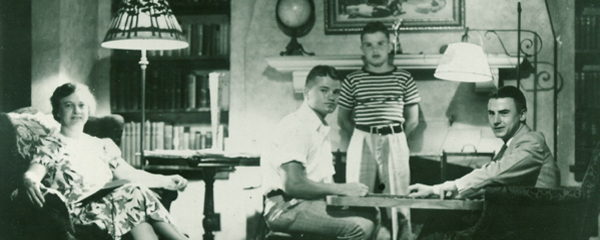
('Nile Kinnick with Mother and Brothers' © Iowa Digital Library, 2011)
THE FAMILY DYNAMIC
By J.L . BOGENSCHNEIDER
‘CHRISTMAS NOT JUST ONCE A YEAR’ BY HEINRICH BÖLL
and
‘THE HEALTH OF THE SICK’ BY JULIO CORTÁZAR
In ‘Christmas Not Just Once A Year,’ Aunt Milla is unwell, affected by a mental disorder. She adores Christmas, but the inconveniences of the war have put a halt to most elaborate festivities. Decorative firs are a luxury item. Treats like marzipan and chocolate rings are scarce. The fragile glass dwarves that hang from the tree and strike a gentle bell-anvil with their hammers must be wrapped in paper and stored away; the angel that once sat atop the tree proclaiming peace is silenced, and Aunt Milla is forlorn.
But the period after 1945 brings real peace and, though times are still tough and rationing remains in force, Uncle Franz is able to secure a tree for this first Christmas without conflict. The glass dwarves are unwrapped and hung, the whispering angel placed atop the fir. The family gathers together, the priest is invited to perform a simple service. Carols are sung. The angel proclaims.
But on Candlemas Eve, Johannes, the eldest son, attempts to remove the decorations and Aunt Milla sends up a terrible scream and cannot be pacified. Doctors and psychiatrists are summoned, to little avail. Aunt Milla howls non-stop for a fortnight until Uncle Franz hits on the simple expedient of holding the Christmas ceremony again: the tree is redecorated, the family gathers together. The priest invited and the service is repeated. Carols once more are sung. With the first chimes of the dwarves’ axes Aunt Milla finds her peace.
However, it is a peace that can only be created by repetition, a proposal that does not pass without its critics: Franz the Younger advocates an exorcism. But after much pleading, Franz Senior’s wishes are acceded to and so the bizarre ceremony is performed night after night, throughout the year, during all seasons, right up until the following Christmas.
This takes its toll on the family: Lucie, the youngest daughter, is briefly committed and flirts with existentialism, Johannes becomes a communist and Uncle Franz takes a mistress. The only person who appears undisturbed is Aunt Milla; even when her family conspire to replace themselves with actors and the grandchildren with wax models. At one late stage, the only original participants in the ritual are Aunt Milla, herself, and an otherwise ignorant curate, the original priest having abandoned the family entirely. Even then, there is no appreciable drop in her mood. For Aunt Milla the pretence, for all its obvious fraud, is preferable to the truth.

Milla is delusional, whether wilfully or not is unclear, but her family continue to placate her the only way they can: via an increasingly complex deception in which they conspire to conceal the truth. In the end, it is to the conspirators’ detriment: Uncle Franz’s moral decline reaches its nadir; Lucie and her husband flee to a country where the importing of Christmas trees is verboten; Johannes is confirmed to be a fully-fledged Communist. Even Franz Junior, previously the only one exhibiting anything approaching common sense about the whole affair (his suggestion of an exorcism at least didn’t pander to his mother’s delusion) has taken holy orders and sequestered himself in a monastery. The family’s decline appears to be inevitable. Aunt Milla remains oblivious to anything out of place. In any event, we are told, the ritual goes on.
In ‘The Health Of The Sick,’ Clelia is unwell, afflicted with a physical illness. This causes the family concern as they worry about what to tell Clelia’s sister, their hypersensitive and bedridden Mama. Because of her frail condition, the death of Mama’s youngest son, Alejandro, in a car accident a year earlier, remains unknown to her. At the time of the accident, the family physician proposed gently preparing her for the shock, but even Maria-Laura, Alejandro’s fiancée, acknowledged that telling her was out of the question. Uncle Roque, out of love for Mama, decides Clelia’s condition is not to be disclosed.
Rather than tell Mama the truth about Alejandro, a story is concocted that business has taken him to Brazil. She is naturally upset, and even made to feel guilty for weeping over his achievements, but accepts his absence as a condition of his success. To better augment the lie, letters are dictated and ‘sent’ to Alejandro, and letters ‘from him’ are received saying that all is well.
But Mama seems suspicious and questions the reality her family present to her, particularly when Alejandro’s letters fail to address her in his particular and secret way. For the family however, ‘The only thing that mattered… was that time pass and that Mama not realize anything,’ regardless of the strain exerted on everyone. The charade must go on, if only for the health of the sick. ‘News’ of Alejandro continues to be mediated via the family and Mama is at peace.
As with the hard-won calm in ‘Christmas Not Just Once A Year’, the peace can only be maintained by repetition, a proposal that requires the collusion of Maria-Laura, who continues her weekly visits and endures Mama’s painful questions about when she and Alejandro might marry. When Mama starts to insist that her son make arrangements to visit her some time, the family’s resolve wavers.
Is she ready for the news, the family asks Doctor Bonifaz? He advices caution and a compromise is arrived at: Uncle Roque tells Mama that Alejandro has fractured his ankle, but even this induces in her a fit and she must be revived with salts. The truth remains out of the question and Mama insists that a letter is sent to Alejandro exhorting him to take care. This time it is Mama’s daughter and bedside attendant – Pepa – who writes to her dead brother, ‘not knowing why she was writing one sentence after another…’
The family recognises the absurdly complex situation they have created, but even when Mama’s credulity appears to be crumbling there is no way back. Alejandro’s latest reply arrives replete with the usual excuses and Mama is disturbingly serene. Does she know? If so, she says nothing, and the fraud goes on until Mama’s health declines, although she remains lucid to the very end. The family gather round her bed as she muses how good they’ve been to her: ‘All that trouble you went through so I wouldn’t suffer.’ Perhaps there are certain things that a mother – and a sister – can’t help but intuit. The family falls victim to their own unreality and it is Mama who is left to state the truth of things.
 Here then, are two families faced with the same problem: a fragile individual who must be protected from the truth at all costs. The themes of each story are different: ‘Christmas Not Just Once A Year’ is a story in which certain quarters of German post-war society are satirised, by way of a family whose attempts to process the distasteful events of recent history are dominated by Aunt Milla’s denial of certain realities. ‘The Health Of The Sick’ is a conventionally straightforward tale of a simultaneously functional and dysfunctional family (is there any other kind?) whose attempts to save their mother from knowing particular painful truths prevent everyone from processing necessary experiences such as grief. Their commonality is the employment of the family dynamic as a narrative lens and the use of familial dysfunction to drive the plot. The lies we tell those closest to us in order to protect. Deception as love.
Here then, are two families faced with the same problem: a fragile individual who must be protected from the truth at all costs. The themes of each story are different: ‘Christmas Not Just Once A Year’ is a story in which certain quarters of German post-war society are satirised, by way of a family whose attempts to process the distasteful events of recent history are dominated by Aunt Milla’s denial of certain realities. ‘The Health Of The Sick’ is a conventionally straightforward tale of a simultaneously functional and dysfunctional family (is there any other kind?) whose attempts to save their mother from knowing particular painful truths prevent everyone from processing necessary experiences such as grief. Their commonality is the employment of the family dynamic as a narrative lens and the use of familial dysfunction to drive the plot. The lies we tell those closest to us in order to protect. Deception as love.
An obvious question to ask of ‘The Health of the Sick’ is why doesn’t Mama expect Alejandro or Clelia to call her? The family wonders this also. One possible suggestion is that she is not fooled, but consciously complicit in her own deception: the family’s love for Mama leads them to deceive her and, in turn, Mama’s love for the family leads her to deceive them.
Conversely, in ‘Christmas Not Just Once A Year’ Aunt Milla shows no interest in the truth and at no point does anyone attempt to cast doubt on any psychological explanations for her symptoms; no-one presumes her condition is anything other than genuine. A fair assumption then is that the entire family is in denial too: their love for Aunt Milla leads them to deceive her and so – in turn – themselves.
But it’s not just the families who are at fault. Doctor Bonifaz advises Cortázar’s family against candour more than once, conspiring to conceal truths that might be far better faced up to. He shares responsibility for the prolonging of the absurdities, going so far as to surrender his ethics and duty towards a patient. For Cortázar, the doctor represents an extension of family into a community, willingly complicit in a fraud in service of a nobler cause.
In Böll’s story, the local priest agrees to partake in the plot, conspiring to conceal truths that might far better be faced up to. He shares responsibility for prolonging the absurdities, although he draws a line and ultimately washes his hands of the entire affair. For Böll, the Priest represents the hypocrisy of the Church, willingly – if conditionally – complicit in a much more serious denial.
The family dynamic is a unique, powerful force capable of motivating parties beyond their quotidian limits: Böll’s allegorical clan are willing to indulge in a collective amnesia for Aunt Milla, the better for her to cope with unpleasant matters, even to their own detriment. Their motivations, however well-intended are ultimately flawed. Certain truths must be confronted out of necessity, and self-deception is a difficult habit to sustain. In the end, individual members of the family seek refuge from the charade in their own ways. As Franz the Younger says, ‘Our life is our punishment.’
For Cortazar’s family too, self-deception proves impossible to maintain. When Alejandro’s final letter arrives, Rosa opens and then reads it ‘without a second thought, and when she raised her eyes because they were suddenly blinded by tears, she realized she had been thinking about how she was going to break the news to Alejandro that Mama was dead.’
~
 Bio: JL Bogenschneider is a writer of short fiction, with work included in Ambit, Bare Fiction, Passages North, PANK and Story Magazine.
Bio: JL Bogenschneider is a writer of short fiction, with work included in Ambit, Bare Fiction, Passages North, PANK and Story Magazine.

One thought on “The Family Dynamic”
Comments are closed.